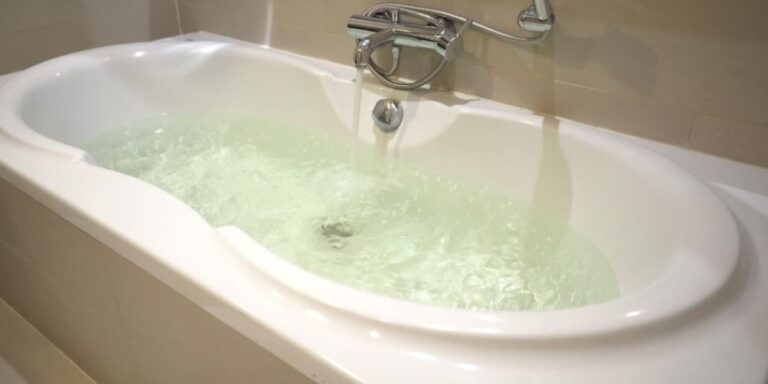How to Remove Brown Stains from a Fiberglass Bathtub?
Nothing ruins the clean, pristine look of a fiberglass tub quite like stubborn brown stains. That dull, dirty discoloration seems to mock your best scrubbing efforts. While fiberglass tubs resist staining better than porcelain, discoloration still happens over time.
Identifying the cause is the first step toward targeted removal. Efforts like baking soda scrubs, bleaches, acid soaks, and sanding can help erase many types of stains without calling a pro.
This article will cover the likely sources of various brown stains and the cleaning methods that work on each type. With some elbow grease and the right products, you can often restore that like-new white appearance. Let’s explore the steps to revitalize your tub!
First, How to Identify the Source of the Stains?
Brown stains can stem from a variety of sources. Pinpointing the exact cause will make targeting your removal efforts much easier. Look closely at the stains and consider what may have caused them.
Rust – If stains are concentrated around faucets, fixtures, or the drain, rust is the likely culprit. As metal fixtures age, rust builds up. Its reddish-brown color stains everything it touches. Rust stains need special removal treatment.
Hard Water – In areas with high mineral content in the water, brownish scaling and buildup can form. Calcium and magnesium bind to soap scum and evaporate as water dries. These mineral deposits etch into the tub surface over time. An acidic cleaner helps dissolve them.
Mold/Mildew – In humid environments, dark brown mold and mildew growth can start stubbornly staining your tub. Check corners, crevices, and any caulked areas for fuzzy buildup indicating mildew. Bleach solutions kill and remove it.
Dirt/Soap Scum – Plain old dirt, grime, and soap scum are also common causes of dingy buildup and stains. A good scrubbing with baking soda or scouring powder removes these.
Bath Products – Staining can occur from bath bombs, oils, or products that contain pigments or minerals. Rinse any colorful or glittery products right after use to avoid permanent discoloration.
Once you identify the type of stain, move ahead with targeted removal techniques. Don’t just assume it’s simple dirt – the brownish tone likely has a specific origin. Pinpoint it for cleaning success.
How to Clean Brown Stains from a Fiberglass Bathtub?
For stains caused by dirt, soap residue, body oils, and bath products that only affect the tub’s surface, abrasive cleaners often do the trick. Try these popular approaches to remove surface Stains.
Baking Soda Scrub
Mix baking soda and just enough water to form a wet paste. Apply to stains and let sit 5-10 minutes. Gently scrub with a soft brush or cloth. Rinse well. Baking soda works on soap scum, oils and minor surface stains without damaging the tub.
Vinegar or Citric Acid Soak
For hard water staining, fill or cover stains with undiluted white vinegar or citric acid solution. After 30-60 minutes, scrub with a soft cloth and rinse. Acidic solutions dissolve mineral deposits and etching.
Bleach Scrub
A paste of bleach and baking soda scrubs away dirt, mold, and soap buildup. Spot test first, as bleach can dull fiberglass over time. Rinse thoroughly after use.
Magic Eraser Abrasion
Gently rub stains with a damp magic eraser sponge to abrade away discoloration. Take care not to over-scrub, as this can damage the fiberglass.
Mild Abrasive Cleaner
For stubborn buildup, a powder or soft cream abrasive cleaner like Comet, Bar Keeper’s Friend, or Zud applied with a non-scratch scrub sponge can lift stains without damaging the tub surface.
If stains remain after trying these techniques, you may need to use a bit of sanding or professional refinishing for full removal. But start gently before taking more aggressive measures.
Eliminating Rust Stains
Rust presents one of the toughest staining challenges. Specialized chemical cleaners or sanding may be needed to fully remove rust etching.
Chemical Rust Removers
Products with oxalic or phosphoric acid help dissolve and detach rust staining. Follow product instructions carefully and rinse thoroughly after the recommended dwell time.
Sanding Down
For deep rust staining, it may be necessary to sand the affected area with fine 120-150 grit sandpaper to remove all traces of rust. Avoid abrasive pads. Re-coat sanded areas with fiberglass epoxy or gel coat for protection.
If stains are coming from rusting fixtures, remove the source by replacing outdated metal pipes, drains, and faucet parts with modern corrosion-resistant options. This prevents ongoing rust issues.
Removing Mineral Deposits
Hard water staining and mineral buildup also require acidic products or abrasion to fully remove etched-in calcium and magnesium deposits.
Lemon Juice and Borax
Make a paste of lemon juice and borax powder. Apply to stains, allow to sit for 30 minutes, then scrub with a cloth and rinse. The citric acid tackles the mineral buildup.
Chemical Descaler
Products made to dissolve mineral buildup in kettles or other appliances can also work on hard water tub stains. Just check they are safe for use on fiberglass. Let it soak then scrub gently.
The sooner you treat hard water staining, the easier removal will be. Maintain your tub by periodically wiping it with white vinegar to prevent heavy mineral etching.
How to Prevent Permanent Brown Staining From Fiberglass Tub?

Your best defense against severe tub staining is preventing it in the first place. Here are some great proactive steps to avoid permanent discoloration down the road:
Rinse Products Quickly
Don’t let colored bath products sit. Rinse any residues immediately after bathing to avoid stubborn staining issues.
Use a Tub Liner
Plastic tub liners protect the underlying surface from contact stains. Replace them periodically to keep your tub looking fresh.
Re-Coat Annually
DIY tub refinishing kits let you re-apply a protective acrylic or epoxy coating once a year to prevent staining and dullness.
Check Fixtures
Replace any leaky or rusting metal fixtures and pipes to avoid ongoing rust staining.
Clean Regularly
Don’t allow soap scum, oils, and grime to build up. Frequent gentle scrubbing keeps your tub stain-free.
With vigilance, you can keep your tub looking like new for years. But once stains set in, try the removal methods covered to refresh the tub’s appearance.
Still Confused What to do, Call for Professional Help
While many stains can be removed with elbow grease and cleaning solutions, severe discoloration or damage may call for professional refinishing. Consider hiring an expert tub pro when:
- Stains cover more than 30% of the tub surface. Removing such extensive staining yourself risks damaging the tub. Let a pro do it safely.
- DIY efforts haven’t fully removed stubborn stains after multiple attempts. The right commercial-grade solutions will get the job done.
- The original finish is damaged or worn after cleaning. A pro can re-coat the tub for long-lasting protection.
- Severe rust or calcium etching requires sanding that risks harming underlying layers. A refinishing pro has the proper tools.
- You don’t have the time or energy for intensive stain removal and want fast, guaranteed results.
Yes, professional refinishing costs more than DIY methods. But if stains are widespread or highly stubborn, the pros have the expertise and heavy-duty products to restore your tub without the hassle. And costs are still far less than full bathtub replacement.
Removing Unwanted Discoloration
Brown stains happen, but they don’t have to be permanent eyesores or lead to expensive replacement. Odds are that with some determination and the right cleaning methods, you can erase many types of stubborn tub stains at home. Start gentle then increase intensity if needed – but know when to call in the pros for heavy stain damage.
Final Key Takeaway:
Here’s hoping these tips help you banish those ugly brown stains for good and enjoy a bright, lustrous tub once more. Don’t let stubborn discoloration ruin your bathing experience or become an annoyance every time you clean.
Tackle it head-on by identifying the cause, troubleshooting smart solutions, and taking preventative steps moving forward. With some strategic scrubbing, you can restore your fiberglass tub’s pristine, welcoming look for a fraction of the replacement cost. Just be sure to wear goggles and gloves – safety counts too when battling bath stain woes!
Can Bath Fitter Go Over a Fiberglass Tub?
Which is Better: Fiberglass or Steel Bathtub?

William J. Bullock is a licensed plumber with over 15 years of experience installing and repairing bathtubs. He runs his own plumbing company in Greenville and serves residential and commercial clients. William is dedicated to providing honest, transparent advice to help homeowners make informed decisions about their bathroom renovations.
He has established expertise in selecting bathtubs, planning custom installations, diagnosing issues, and completing repairs. William aims to share practical tips and reliable recommendations based on extensive hands-on work. When he isn’t on a job site, William enjoys spending time with his family and volunteering at local community events. He takes pride in delivering quality service and enjoys helping people upgrade their homes.







